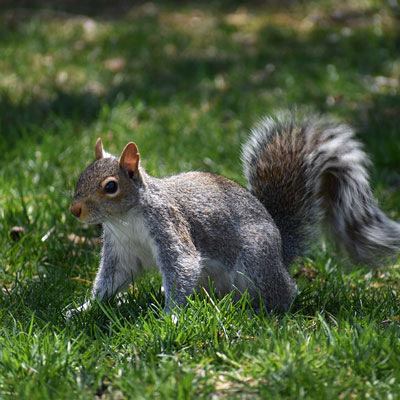How to Get Rid of Squirrels
Squirrels are one of the most commonly found wildlife creature. You’ve probably seen these cute little bushy-tailed creatures running and playing in your backyard or at a park at least five hundred times. They are not aggressive and most will scamper up the nearest tree if you get too close. It doesn’t matter what area you’re located in, you can more than likely find a squirrel playing in a tree everywhere as there are over 200 species of squirrel running around all over the world!
These little guys range in size; the smallest being the African Pygmy Squirrel growing to about 5 inches, to the largest being the Indian Giant Squirrel growing up to 36 inches! I don’t know about you, but I would be terrified if a 36 inch squirrel came down from a tree at me. The squirrel you are more than likely seeing, however, is the Grey Squirrel, these little guys are the most common squirrels in North America.
Squirrels can be broken up into three different main types: Tree Squirrels, Ground Squirrels, and Flying Squirrels. Tree Squirrels live in trees, obviously, this is the type that the Grey Squirrel belongs to which is why you can always find them running up the trees in your yard. Ground Squirrels dig burrows underground that they live in, these types of squirrels are also known to hibernate in the winter. Flying Squirrels nest mostly in tree holes, or in the crooks of the branches. The Flying squirrel does not technically fly, however, they can glide for extended periods of time due to the flaps of skin between their legs and bodies.
Despite popular belief, squirrels do not exclusively eat nuts. In fact, squirrels are omnivores, meaning that they eat both vegetation and meat. Mostly they will eat seeds and fruit, but they also love to munch on caterpillars and small animals if given the opportunity. Squirrels are also well known for burying their food for the winter, this way they always have access to food supplies even if they live in places where winters can be harsh and destructive. This behavior has helped to grow many oak trees, as squirrels will forget where they buried their acorns and come spring, an oak tree will start to sprout.

The exclusion process is probably the most important step of the process, as it ensures that no additional animals can gain access to your home. Basically, an exclusion is the sealing up of any access points on your home. All animals leave pheromones behind that other animals can follow, so even if you move your squirrel to Antarctica (please don’t they won’t survive), more squirrels can find their way in if you don’t seal up your home properly. Also, you want to make sure that all squirrels have been removed from your attic before you seal up the final hole, if a squirrel gets trapped in your attic they could end up passing away and that is not a very pleasant odor.
When you begin the exclusion process you want to look for any obvious opening first: roof returns, pipe stacks, vents, and any holes. Then you need to go back over the house with much more scrutiny and identify any small access points you might have missed. To seal any minor holes or access points, it is best to use a steel wiring cover enforced with bolts. The metal is almost impossible for squirrels to chew through and the bolts make it impossible for them to pull off.
If you notice holes chewed through soffit or wood, you may have to replace this. If there is significant wood damage, it might be best to contact a contractor and get their opinion on how to handle replacement of wood so that you don’t cause any damage to the structural integrity of the home. If it is something you feel confident in patching, though, patches are also great for covering access points.
It is best to get the exclusion process done immediately after removing the squirrels from the attic to prevent any future intrusion from their nosy friends.

Once the squirrels are gone and your home is sealed up, you feel like you can finally take a breather. BUT WAIT. There’s more. Remember that poop we talked about? Yeah, that’s still there. Gross, I know. So, the absolute final step before you can finally get a peaceful night’s sleep is cleaning up the mess these guys left behind. It’s kind of like inviting rude toddlers into your home, they destroy everything and then leave. Sadly, you’re still the one having to clean up after everything.
Squirrels (and any animal) will also leave pheromones behind, which can bring a lot more animals around the area. Now, if your house is sealed up properly it might not be an issue that they’ll get inside but you could have many more unwanted guests trying to figure out how to get in. I’m not going to lie and say that cleaning up after these guys is a glamorous or easy task, so you’re going to want latex gloves and a face mask.
Best case scenario: they didn’t do too much damage to insulation and you’re able to go in with paper towels and pick up the droppings manually. Remember to wear your gloves and mask!!!! Then go over everything you can with a disinfectant or if you feel comfortable- with bleach and water.
Worst case scenario: the squirrels did a number on your insulation. I wish I could tell you that this is an easy to manage task, but if your insulation is badly damaged, you’re going to need to contact an insulation specialist. Like I said, WORST case scenario.
With all the droppings cleaned, the area disinfected, your house sealed up, and most importantly the squirrels gone. I think it’s time you got that full night of peaceful sleep you’ve been waiting for!